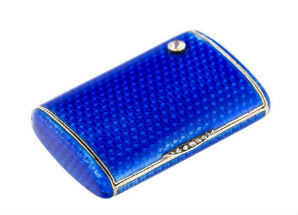
NEW YORK – Long before matches came to be, fire was produced through friction or focusing sunlight on combustible material. By the 1700s, people commonly lit candles, lanterns, stoves and cigars by striking pieces of flint against fire-steels, which sparked slow-burning, charcloth tinder. Many kept these flame-producing trios in cumbersome tinder boxes.
Red phosphorus-tipped lucifer splints reached the British market in the 1830s. These strike-anywhere friction matches, however, unintentionally ignited when touching coarse surfaces. So, gentlemen (women did not smoke) stored them safely in small, tightly closed vestas, pocket-size cases named for the Roman goddess of hearth, home and fire. These are also known as match safes in the United States.

Vestas, initially adapted from oval, oblong, rectangular, round or pillow-formed Georgian snuff boxes, featured ribbed exterior or interior strikers. To prevent stray sparks from transforming them into firebombs, however, their flip-top, hinged lids were set on their base. Many also bore rings for linking to fashionable “Albert” watch chains, which were draped in pockets.
“Combination” personal vestas, in addition to storing lucifers, sometimes incorporated tiny, useful items like knife blades, pencils, cigar cutters, whistles or space for full or half gold sovereigns.

Larger table ones were conveniently kept at hearthsides, in smoking rooms and at gentlemen’s clubs. Metal, wood or ivory “go-to-bed” mantelpiece models, designed to prevent igniting delicate canopy bed curtains, featured candle-like finials that flickered for mere seconds — enough time for the user to light them and then hop into bed.

Through the years, pocket vestas, like mustache styles, hats and neckwear, reflected a man’s personality and social status. Working-class smokers often used giveaways made of tin, gunmetal, celluloid or vulcanite that promoted, for example, banks, billiards, beer or whiskey.

More sophisticated smokers often preferred classier vestas featuring hunting, sporting, gambling, drinking or dancing motifs. Some commemorated visits to Niagara Falls, the Statue of Liberty or the 1904 St. Louis World’s Fair. Others celebrated Queen Victoria’s Golden Jubilee or the reign of Edward VII.

The wealthy usually preferred costly, handcrafted solid gold or sterling silver vestas with anti-corrosive gilt interiors. Many bore ornate initials, empty cartouches edged with scrolling florals, or all-over ribbed, hammered, woven or wavy textures. Others, following fashion, featured stylized natural motifs, flowing scroll and acanthus leaf designs, or images of damsels with flowing tresses.

Despite so many choices, many smokers, whatever their class or calling, found vestas depicting risqué beauties (safely pocketed unless in male company) most desirable of all.
Others preferred the whimsy of brass or bronze novelty ones. Many are shaped like owls, turtles, coiled snakes, or cat, dog or horse heads. Others, fashioned like pianos, jockey caps, dominoes or fishing creels, for instance, reflect common pastimes and passions. Some, resembling lanterns, high-button shoes, gloves, visiting cards or Brazil nuts, a costly, imported, Victorian Christmastime treat, today evoke bygone times.
So do the lyrics of this popular World War I song:
Pack up your troubles in your old kit bag,
and smile, smile, smile
While you’ve a lucifer to light your fag,
Smile, boys, that’s the style
Apparently, lucifer-filled vestas raised military morale.
As more practical, modern lighters reached the market, however, vesta gradually disappeared from use. Today, history buffs, fashionistas and art lovers value these fascinating, functional pieces as objets d’art. Some seek classics by legendary Birmingham silversmiths, especially those bearing identifying hallmarks or maker marks. Some seek pieces featuring a particular material or motif. Many collect ones by prestigious jewelers like Alfred Dunhill, Sampson Mordan, Gorham or Unger Bros. Others prize exquisitely wrought Imperial Russian vestas, like Faberge’s dramatic, intricately patterned, vividly hued, gold-rimmed guilloché creations.
Most vestas, well used, are well worn. Yet in the eyes of many, this only increases their charm.



